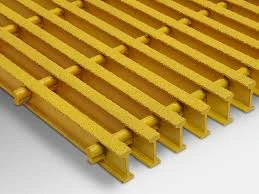loading...
- No. 9, Xingyuan South Street, Dongwaihuan Road, Zaoqiang County, Hengshui, Hebei, China
- admin@zjcomposites.com
- +86 15097380338
- Welcome to visit our website!
Innovative Fiberglass Reinforced Polymer Pultruded Profiles for Diverse Applications
Understanding FRP Pultruded Profiles Advantages and Applications
Fiber Reinforced Polymer (FRP) pultruded profiles are emerging as a revolutionary material across various industries due to their exceptional strength-to-weight ratio, corrosion resistance, and versatility in design. The pultrusion process, a continuous manufacturing method, allows for the production of composite materials with uniform cross-sections, making FRP profiles an optimal choice for various applications, from construction to aerospace.
What are FRP Pultruded Profiles?
FRP pultruded profiles are produced through a process where fibers (usually glass or carbon) are pulled through a resin bath and subsequently through a heated die. This method not only ensures consistent fiber alignment but also effective impregnation with resin, resulting in a strong, lightweight composite. The profiles can be customized in terms of size, shape, and material composition, accommodating the specific needs of different applications.
Advantages of FRP Pultruded Profiles
1. High Strength-to-Weight Ratio One of the most significant advantages of FRP profiles is their high strength-to-weight ratio. This characteristic makes them ideal for applications where reducing weight is essential without compromising structural integrity, such as in transportation and construction.
2. Corrosion Resistance FRP materials are highly resistant to corrosion, making them suitable for use in harsh environments. For instance, in chemical processing plants or coastal areas, where traditional materials may deteriorate, FRP profiles maintain their performance and extend the lifespan of structures and components.
3. Low Maintenance The durability and resistance to environmental factors translate to lower maintenance costs over time. This makes FRP profiles an economically advantageous choice for long-term projects.
4. Design Flexibility The pultrusion process allows for a wide range of shapes and sizes, facilitating innovative designs. Complex geometries can be achieved, enhancing aesthetic appeal as well as functionality in architecture, bridges, and other structures.
5. Thermal and Electrical Insulation FRP materials possess excellent insulating properties, making them suitable for electrical applications. They are also effective in environments where thermal insulation is required, thereby increasing energy efficiency.
frp pultruded profiles

Applications of FRP Pultruded Profiles
FRP pultruded profiles find applications in diverse sectors
1. Construction Due to their strength and lightweight properties, FRP profiles are widely used in constructing bridges, building facades, flooring systems, and railings. Their corrosion resistance makes them particularly valuable for structures exposed to moisture or chemical agents.
2. Aerospace and Automotive The aerospace industry benefits from the lightweight nature of FRP materials, contributing to enhanced fuel efficiency. Similarly, automotive manufacturers utilize FRP profiles to reduce vehicle weight while maintaining safety and performance.
3. Marine Applications In the marine sector, FRP profiles are utilized for boat construction, docks, and piers, where their resistance to saltwater and rot is critical for longevity.
4. Infrastructure FRP profiles are increasingly employed in infrastructural applications, including utility poles, walkways, and grating systems. Their resistance to environmental degradation makes them an ideal choice for these uses.
5. Sports and Recreation The sports industry uses FRP profiles in the construction of equipment like poles, racks, and composite sporting goods thanks to their lightweight and durable nature.
Conclusion
FRP pultruded profiles represent a significant advancement in material technology, providing engineers and designers with a versatile solution for modern challenges. Their exceptional properties, coupled with a wide range of applications, position them as a key material in the ongoing evolution of construction methods and product design. As industries continue to seek sustainable and efficient materials, FRP profiles will undoubtedly play a pivotal role in shaping the future of engineering and manufacturing.
-
GRP Structures: The Future of Lightweight, High-Performance EngineeringNewsJun.20,2025
-
FRP Water Tank: High-Performance Storage for Corrosive and Clean Water SystemsNewsJun.20,2025
-
FRP Square Tube: The New Industry Standard for Chemical and Structural ApplicationsNewsJun.20,2025
-
FRP Pultruded Profiles: The Ultimate Choice for Lightweight Structural StrengthNewsJun.20,2025
-
FRP Handrails: The Safer, Smarter, and Stronger Choice for Modern InfrastructureNewsJun.20,2025
-
FRP Grating: The Smart Solution for Durable, Lightweight Industrial FlooringNewsJun.20,2025
-
Why Choose a Galvanized Water Tank for Your Storage NeedsNewsMay.21,2025
